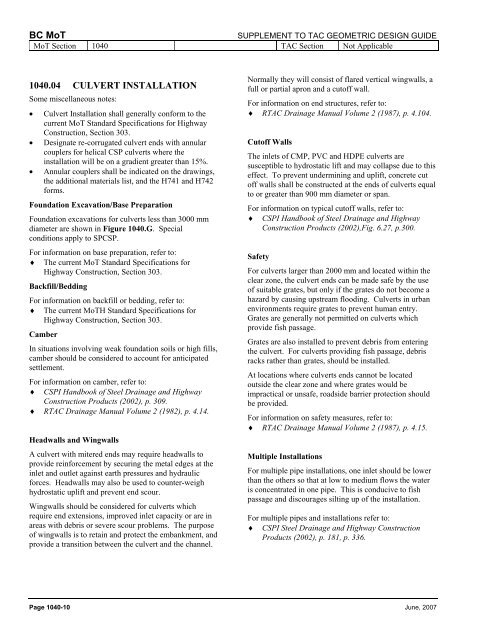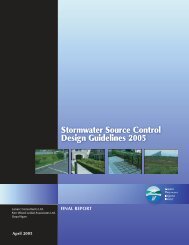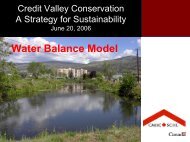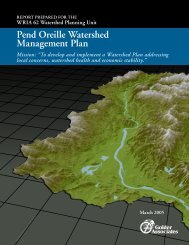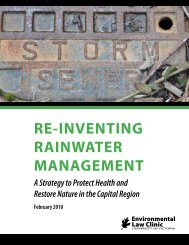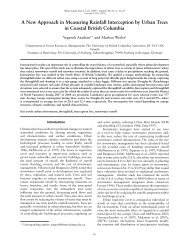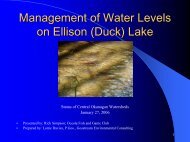1000 Hydraulics Chapter - Ministry of Transportation
1000 Hydraulics Chapter - Ministry of Transportation
1000 Hydraulics Chapter - Ministry of Transportation
You also want an ePaper? Increase the reach of your titles
YUMPU automatically turns print PDFs into web optimized ePapers that Google loves.
BC MoT<br />
SUPPLEMENT TO TAC GEOMETRIC DESIGN GUIDE<br />
MoT Section 1040 TAC Section Not Applicable<br />
1040.04 CULVERT INSTALLATION<br />
Some miscellaneous notes:<br />
• Culvert Installation shall generally conform to the<br />
current MoT Standard Specifications for Highway<br />
Construction, Section 303.<br />
• Designate re-corrugated culvert ends with annular<br />
couplers for helical CSP culverts where the<br />
installation will be on a gradient greater than 15%.<br />
• Annular couplers shall be indicated on the drawings,<br />
the additional materials list, and the H741 and H742<br />
forms.<br />
Foundation Excavation/Base Preparation<br />
Foundation excavations for culverts less than 3000 mm<br />
diameter are shown in Figure 1040.G. Special<br />
conditions apply to SPCSP.<br />
For information on base preparation, refer to:<br />
♦ The current MoT Standard Specifications for<br />
Highway Construction, Section 303.<br />
Backfill/Bedding<br />
For information on backfill or bedding, refer to:<br />
♦ The current MoTH Standard Specifications for<br />
Highway Construction, Section 303.<br />
Camber<br />
In situations involving weak foundation soils or high fills,<br />
camber should be considered to account for anticipated<br />
settlement.<br />
For information on camber, refer to:<br />
♦ CSPI Handbook <strong>of</strong> Steel Drainage and Highway<br />
Construction Products (2002), p. 309.<br />
♦ RTAC Drainage Manual Volume 2 (1982), p. 4.14.<br />
Headwalls and Wingwalls<br />
A culvert with mitered ends may require headwalls to<br />
provide reinforcement by securing the metal edges at the<br />
inlet and outlet against earth pressures and hydraulic<br />
forces. Headwalls may also be used to counter-weigh<br />
hydrostatic uplift and prevent end scour.<br />
Wingwalls should be considered for culverts which<br />
require end extensions, improved inlet capacity or are in<br />
areas with debris or severe scour problems. The purpose<br />
<strong>of</strong> wingwalls is to retain and protect the embankment, and<br />
provide a transition between the culvert and the channel.<br />
Normally they will consist <strong>of</strong> flared vertical wingwalls, a<br />
full or partial apron and a cut<strong>of</strong>f wall.<br />
For information on end structures, refer to:<br />
♦ RTAC Drainage Manual Volume 2 (1987), p. 4.104.<br />
Cut<strong>of</strong>f Walls<br />
The inlets <strong>of</strong> CMP, PVC and HDPE culverts are<br />
susceptible to hydrostatic lift and may collapse due to this<br />
effect. To prevent undermining and uplift, concrete cut<br />
<strong>of</strong>f walls shall be constructed at the ends <strong>of</strong> culverts equal<br />
to or greater than 900 mm diameter or span.<br />
For information on typical cut<strong>of</strong>f walls, refer to:<br />
♦ CSPI Handbook <strong>of</strong> Steel Drainage and Highway<br />
Construction Products (2002),Fig. 6.27, p.300.<br />
Safety<br />
For culverts larger than 2000 mm and located within the<br />
clear zone, the culvert ends can be made safe by the use<br />
<strong>of</strong> suitable grates, but only if the grates do not become a<br />
hazard by causing upstream flooding. Culverts in urban<br />
environments require grates to prevent human entry.<br />
Grates are generally not permitted on culverts which<br />
provide fish passage.<br />
Grates are also installed to prevent debris from entering<br />
the culvert. For culverts providing fish passage, debris<br />
racks rather than grates, should be installed.<br />
At locations where culverts ends cannot be located<br />
outside the clear zone and where grates would be<br />
impractical or unsafe, roadside barrier protection should<br />
be provided.<br />
For information on safety measures, refer to:<br />
♦ RTAC Drainage Manual Volume 2 (1987), p. 4.15.<br />
Multiple Installations<br />
For multiple pipe installations, one inlet should be lower<br />
than the others so that at low to medium flows the water<br />
is concentrated in one pipe. This is conducive to fish<br />
passage and discourages silting up <strong>of</strong> the installation.<br />
For multiple pipes and installations refer to:<br />
♦ CSPI Steel Drainage and Highway Construction<br />
Products (2002), p. 181, p. 336.<br />
Page 1040-10 June, 2007


